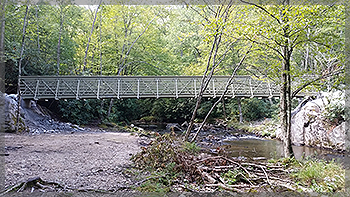 The bridge, located on the Mountain-to-Sea trail off the Blue Ridge Parkway in Blowing Rock, NC, is a seemingly small but mighty project – one which exemplifies the Pinnacle Award criteria because of its unique aspects, special value, construction challenges, safety performance, excellence in project management, budget and schedule considerations.
The bridge, located on the Mountain-to-Sea trail off the Blue Ridge Parkway in Blowing Rock, NC, is a seemingly small but mighty project – one which exemplifies the Pinnacle Award criteria because of its unique aspects, special value, construction challenges, safety performance, excellence in project management, budget and schedule considerations.
With a budget of $250,000 and a six-week schedule to complete this project, NHM was eager to get started. From the onset of this project, Friends of the Mountains to Sea Trail (a group of citizens and volunteers who support the trail) collaborated with Arête Engineers and NHM Constructors on the bridge’s concept, the 6-week time frame, and other preliminary needs. Funding was obtained through two grants: one from the Federal Recreation Trails Program, administered by the NC Division of State Parks; and the other through the Blue Ridge Parkway Foundation. Because the project was being funded by grants and managed by a non-profit organization, there was no wiggle room for cost increases.
Prior to the bridge, the only way for hikers to access the Mountains to Sea Trail was to wade through a creek. Worse yet, the Mountains-to-Sea trail was limited to physically healthy people – hikers who had physical disabilities found it hard, at times impossible, to cross. The installation of this bridge has already added great value to the community by allowing all hikers, no matter their physical limitations, to cross the creek safely. It also allows much easier access to one of only three backcountry campsites on the Parkway.
While the argument could be made that all bridge projects—whether over a bustling highway or a rushing river—come with challenges, this particular bridge’s very location was its greatest challenge. Any time you perform work in a forested area, the impact on the environment alone can make or break the project. Of the many steps NHM took to impact the trail as little
as possible, two stood out to the Pinnacle judges:
- The abutments for the bridge were chiseled into two boulders on opposite sides of the creek, taking advantage of mother earth in a very positive way,
- And to minimize the number of trees that needed to be removed to allow for a landing area for materials being flown into the project site, NHM used an existing sand bar to eliminate the need for downed trees.
Given the job site’s access restrictions, a helicopter with a maximum weight limit of 1,500 pounds was used to deliver materials and equipment to the site. Flight days required coordination between NHM, Arête, Friends of the Mountains to Sea and the Forest Service to arrange for trail closures, parking area closures and traffic control on the Parkway and in the backcountry.
A total of 25 loads were flown in, which consisted of concrete mix, tools, mixers, scaffolding, and bridge materials. Each load had to be weighed and staged according to the order needed during construction, especially since space on the laydown area was limited. The helicopter made 14 additional flights upon completion of the project, to haul out tools and scaffolding. Semi-trucks and ATVs were also used to deliver materials. However, these vehicles came with their own set of issues given they could only be driven part of the way. Crew members then had to hike down a steep slope to reach the project site. These challenges made planning especially important on the front end because anything that was not flown in via helicopter had to be hand carried about a mile to the site.
Due to the unique methods used to deliver materials, traditional steel could not be used on this project due to the weight. Therefore, to lighten the load (literally), the use of fiber reinforced polymer (also known as FRP) material was used. In addition to easing the delivery burden associated with this project, FRP reduced the weight of the overall structure to roughly 11,500 pounds-- which is significantly less than the 20,000 pounds of a traditional steel structure.
It’s important here to note that while the construction of this project took only 6 weeks, planning and preparation began back in 2014 – it was this long span of planning and preparing that helped meet its challenges head on.
While safety is always a major concern and topic of conversation for NHM Constructors, this project came with a unique safety challenge not typical of most job sites. Because of the site’s location, cell phone service was sometimes non-existent, or sketchy at best. And, it would have taken emergency crews additional time to get to the project had they been needed. For these reasons, NHM gave its crew a refresher course in first aid and CPR. Because of risks associated with using aircraft and lowering and lifting loads out of a forested area, safety briefings were held before each flight. These briefings covered topics such as “what to do if the wind blows objects from the aircraft” and “what to do if tree limbs are knocked down by incoming/outgoing loads.” Thanks in part to the training and awareness of NHM’s supervision and crew members, the bridge project experienced no accidents or near misses.
NHM Constructors completed the Mountains-to-Sea Trail Bridge within the 6-week construction schedule, and $10,000 under budget! A small but mighty project.